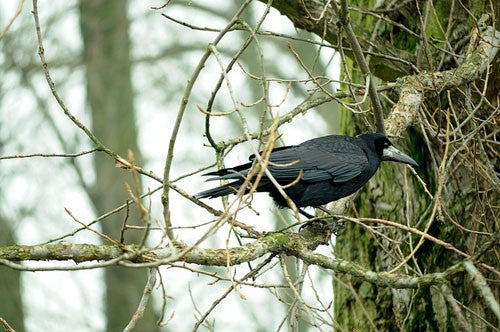The Rook (Corvus frugilegus) is a large member of the crow (Corvidae) family; it is similar in size to the Carrion Crow. It has a slender bill, a bare, greyish-white face.
Its thinner beak and peaked head make it more distinguishable than the crow. It is also known for being untidy in its appearance. When on the ground it has a swagger to its walk and hops with attitude.
Gregarious and often seen with Jackdaws, Rooks are very sociable birds. They are rarely seen alone and breed in colonies, called rookeries, throughout Britain.
They nest at the top of very tall trees – of which Elms seem to be a favourite. It rarely ventures into built-up areas choosing to, instead, feed on farmland.
The most important foods they feed on are grain and soil invertebrates. And according to farmers, they are pests. Away from the countryside, they'll visit bird tables for scraps, fruit, nuts and berries.
There aren't many areas of the UK without resident Rooks. Their population has been increasing each year, which suggests they're adapting well to changes in agricultural practices that many other species find more challenging.
If you do spot a Rook in your garden here's a few nibbles to consider offering:
Waxworms are a meaty mouthful for Rooks. They are the larvae of the wax moth and consume delicious nutrients such as honey and wheat germ. They're very nutritious. Even their soft skins provide a very important source of nutritious food. And that's why they're adored by all insect-eating wildlife.
Store Waxworms at room temperature. That said, we find they last longer stored in a cool garage or even in the fridge!
Providing high-quality bird food throughout autumn and winter helps birds make it through to the breeding season in great shape. As 'natural' food becomes hard to find rest assured that feeding the birds is helping improve their chances of survival.

Written by Tina Jakes


